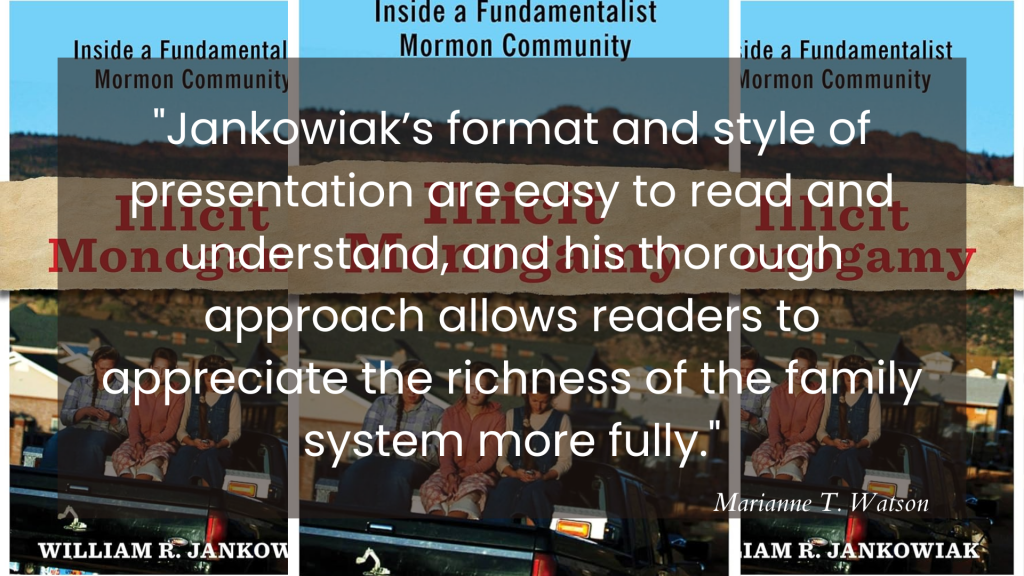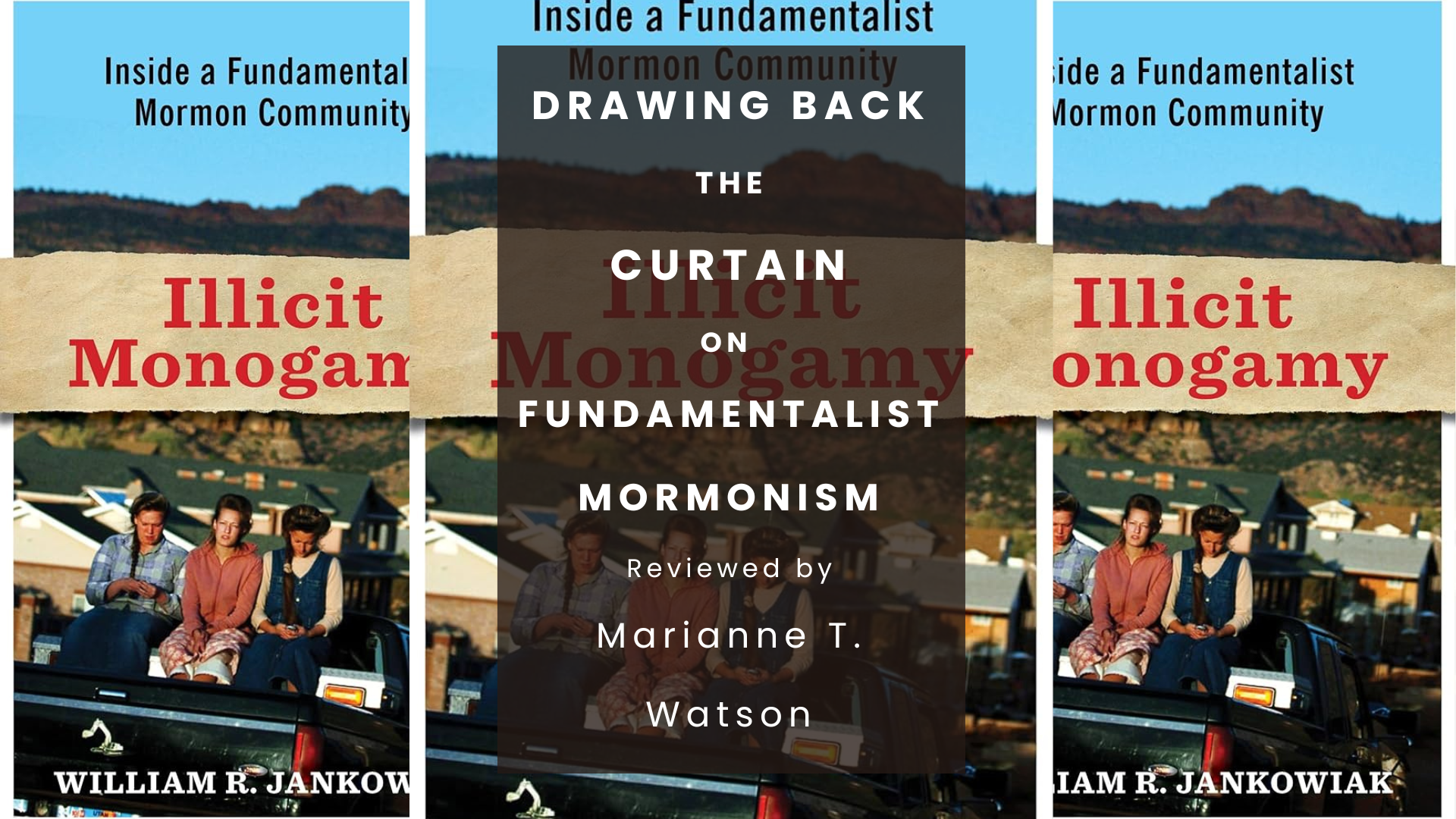Articles/Essays – Volume 57, No. 3
Drawing Back the Curtain on Fundamentalist Mormonism | William R. Jankowiak, Illicit Monogamy: Inside A Fundamentalist Mormon Community
William Jankowiak’s book Illicit Monogamy provides an in-depth look at the intricacies of life in plural families within a specific fundamentalist Mormon community referred to as Angel Park. His work is monumental for its analysis of individuals’ experiences living in polygamous households. He gives outsiders an extensive peek into the world of plural marriage living. His anthropological work also proffers an introspective mirror useful for fundamentalist Mormons—perhaps also for other polygamists around the globe.
As a born-and-raised fundamentalist Mormon (from a different community) and as a plural wife of nearly fifty years, I found the author’s study and analysis thought-provoking. His insights regarding the contradictions inherent in plural life are fascinating. Janowiak uses the term “father adoration” to describe his view of how fundamentalist plural families function. I find the term interesting, but it does not resonate with my own life. However, he does show the wide array of diversity that exists among fundamentalist fathers and their various methods for organizing a family. My experience allows for a deep reverence for some patriarchal fathers in plurality—for those who act reliably in administering wisdom acquired over years of counseling and mentoring their families as well as other community members—but that respect certainly does not apply to all fundamentalist Mormon fathers.
One of the differences between Angel Park and my community is that we frown generally upon the common consumption of coffee and alcohol; instead, our Word of Wisdom standards more closely resemble those of the Church of Jesus-Christ of Latter-day Saints. Also, in my fundamentalist group there is no doctrine of placement marriage. Rather, mutual attraction and free choice are emphasized, especially for women. This is a difference that makes all the difference in many ways. Still, as the author concludes, “every family is different” (267) and adjusts over time, for better or for worse.

Although the author alludes to religious adherence as an important feature for the long-term endurance of fundamentalist Mormon communities, he fails to convey the importance of one vital aspect. Most plural marriage participants consider their marital vows to be covenantal with God—in fact, covenant marriage relationships involving God are considered foundational. For this, a husband and each wife covenant individually with God to fulfill their marriage vows with each other according to His laws. When a husband marries an additional wife, each co-wife ideally consents to support their union as a new dyadic unit within the plural family. The idea is that a vertical connection with God is the basis by which each person derives strength and an increased ability for love, self-discipline, and a needed willingness to sacrifice for others. The theological model for this is personal salvation of each individual soul by and through Jesus Christ—as part of but not separate from Jesus’ ultimate marriage to His bride, the church. From this perspective, personal bonds forged with God through trials enable and empower a bonded marital relationship that in turn strengthens both family and community relationships. Both dyadic and communal relationships are imperative. Theologically, both are centered first in God.
Therefore, I depart from the author’s conclusion that “illicit monogamy,” or the inherent draw toward a fulfilling dyadic relationship, runs counter to the intended function or purpose of a plural family. Rather, I assert that the development of healthy couple relationships within a plural family is one of its primary goals. Ideally, each husband-and-wife relationship is meant to include a high level of intimacy and emotional and spiritual connection. Like the spokes of a wheel, each unique marriage relationship is meant to become a dyadic celestial unit, worthy of transcending beyond mortality within a mutually respective and supportive plural family wheel.
As the author points out in multiple ways, choosing to live plural marriage requires love, commitment, self-discipline, and self-sacrifice. Yet, loving oneself is co-equal with loving your neighbor, as the Bible says. So, while plural marriage incorporates dyadic love, it is not “illicit monogamy.” My grandfather, who married four wives, expressed it this way: “The most beautiful love stories are in principle—if they could only be told.”[1] This is the kind of encouragement expressed by my extended and ancestral family members who lived plural marriage for six generations before me. Yes, plural marriage is difficult and challenging—most challenging—but worth it for many.
Jankowiak’s format and style of presentation are easy to read and understand. Both the notes section at the end and the author’s extensive list of references show his thorough approach. I especially value Jankowiak’s purpose addressed to the residents he studied, and I recommend his book on the same basis: “My primary aim is ‘to allow readers to form their own opinion about the community I found so compellingly complex.’ It is the richness of the family system that I wanted outsiders to appreciate more fully” (xi).
William R. Jankowiak. Illicit Monogamy: Inside A Fundamentalist Mormon Community. New York: Columbia University Press, 2023. 320 pp. Paper: $30.00. ISBN: 9780231150217.
[1] This statement of my grandfather, Joseph Lyman Jessop, was quoted to me during my first year in college (1975–76) by my widowed grandmother, Beth Allred Jessop, who was my grandfather’s third wife in plurality.


 Back to full Issue
Back to full Issue

